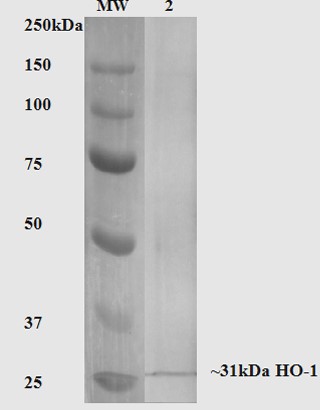Anti-Heme Oxygenase-1 Antibody (Clone 6B8-2F2)
Anti-Heme Oxygenase-1 Antibody (Clone 6B8-2F2)
Product No.: 13062
- -
- -
Clone 6B8-2F2 Target Heme Oxygenase-1 Formats AvailableView All Product Type Monoclonal Alternate Names HO-1, EC 1.14.14.18, HSP32 Isotype Mouse IgG1 Applications ELISA , WB |
Data
- -
- -
Antibody DetailsProduct DetailsReactive Species Human ⋅ Mouse ⋅ Rat Host Species Mouse Immunogen His-tagged rat heme-oxygenase-1 (HO-1) Product Concentration 1.0 mg/ml Formulation Phosphate-buffered saline (PBS), pH 7.4, containing 50% glycerol and 0.09% sodium azide. State of Matter Liquid Product Preparation Purified by Protein G affinity chromatography Storage and Handling This antibody is stable for at least one (1) year at -20°C. Avoid repeated freeze-thaw cycles. Regulatory Status Research Use Only Country of Origin USA Shipping Next Day 2-8°C Applications and Recommended Usage? Quality Tested by Leinco ELISA: confirmed with antibody at 1-10ug/ml binding to 5ug/ml HO-1 on the solid phase.
Immunoblotting: confirmed with antibody at 1.0-2.0ug/ml and 20ug of rat kidney lysate. A band of ~31kDa is detected. Positive control: Rat kidney lysate. These are recommended concentrations; Enduser should determine optimal concentrations for their applications. Each investigator should determine their own optimal working dilution for specific applications. See directions on lot specific datasheets, as information may periodically change. DescriptionDescriptionSpecificity This antibody recognizes human, mouse, and rat HO-1. It does not cross-react with HO-2. Background Heme oxygenase (HO) is a membrane-bound enzyme that catalyzes the degradation of heme into biliverdin, carbon monoxide (CO), and free iron. Biliverdin is subsequently converted to bilirubin, a potent antioxidant. There are two main isoforms of HO: the inducible HO-1 and the constitutively expressed HO-2. HO-1 is upregulated in response to a broad range of stress signals, including oxidative stress, inflammatory cytokines, heat shock, and transforming growth factor-beta (TGF-β). Its induction is considered a key cellular protective mechanism, helping to mitigate oxidative damage through the production of antioxidant byproducts. Due to its role in cytoprotection and inflammation modulation, HO-1 is widely studied in the context of cardiovascular, neurodegenerative, and inflammatory diseases. Function Heme oxygenase cleaves the heme ring at the alpha methene bridge to form biliverdin. Biliverdin is subsequently converted to bilirubin by biliverdin reductase. Under physiological conditions, the activity of heme oxygenase is highest in the spleen, where senescent erythrocytes are sequestrated and destroyed. Exhibits cytoprotective effects since excess of free heme sensitizes cells to undergo apoptosis. NCBI Gene Bank ID UniProt.org Research Area Enzymes References & CitationsTechnical ProtocolsCertificate of Analysis |



